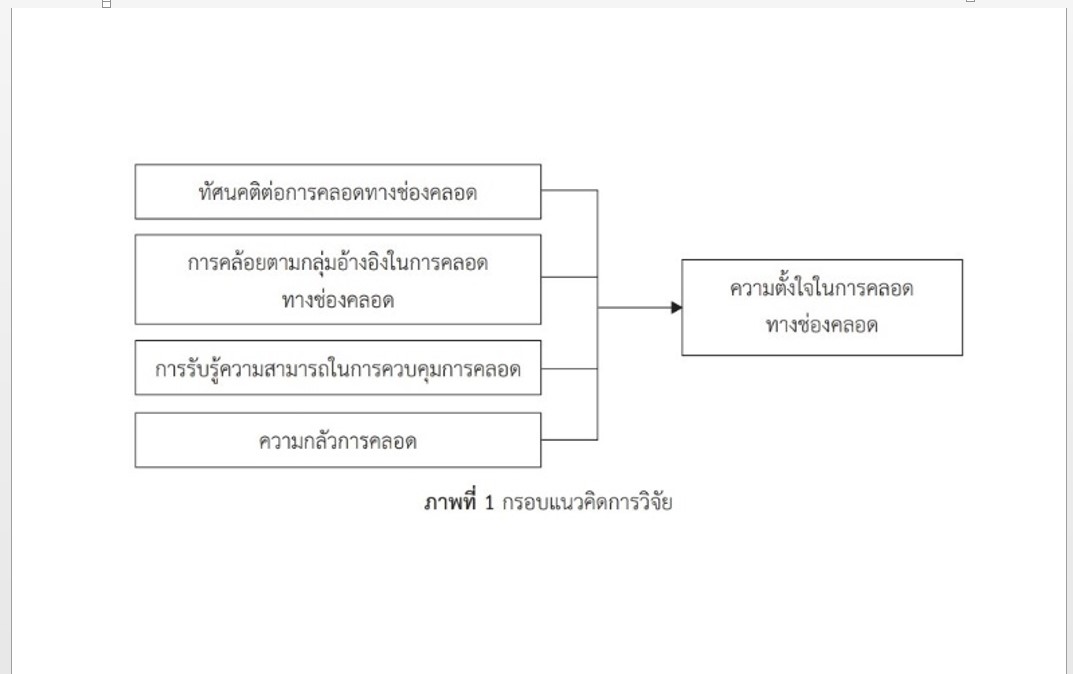ปัจจัยทำนายความตั้งใจในการคลอดทางช่องคลอดของหญิงครรภ์แรก
คำสำคัญ:
ความตั้งใจในการคลอดทางช่องคลอด , ทัศนคติต่อการคลอดทางช่องคลอด , การคล้อยตามกลุ่มอ้างอิงในการคลอดทางช่องคลอด, การรับรู้ความสามารถในการควบคุมการคลอด, ความกลัวการคลอดบทคัดย่อ
การวิจัยแบบหาความสัมพันธ์เชิงทำนายครั้งนี้มีวัตถุประสงค์เพื่อศึกษาความตั้งใจในการคลอดทางช่องคลอด และปัจจัยทำนายความตั้งใจในการคลอดทางช่องคลอดของหญิงครรภ์แรก กลุ่มตัวอย่างคือ หญิงครรภ์แรกที่มารับบริการฝากครรภ์ ณ โรงพยาบาลสมเด็จพระบรมราชเทวี ณ ศรีราชา จังหวัดชลบุรี จำนวน 172 รายซึ่งได้มาโดยการสุ่มอย่างง่าย เครื่องมือที่ใช้ในการเก็บรวบรวมข้อมูล ประกอบด้วย แบบสอบถามข้อมูลส่วนบุคคล แบบสอบถามทัศนคติต่อการคลอดทางช่องคลอด แบบสอบถามการคล้อยตามกลุ่มอ้างอิงในการคลอดทางช่องคลอด แบบสอบถามการรับรู้ความสามารถในการควบคุมการคลอด แบบสอบถามความกลัวการคลอด และแบบสอบถามความตั้งใจในการคลอดทางช่องคลอด มีค่าสัมประสิทธิ์แอลฟาของครอนบาคเท่ากับ 72, .91, .92, .92, และ .95 ตามลำดับ วิเคราะห์ข้อมูลด้วยสถิติพรรณนา และสถิติถดถอยพหุคูณแบบมาตรฐาน
ผลการวิจัยพบว่า หญิงครรภ์แรกมีความตั้งใจในการคลอดทางช่องคลอดอยู่ในระดับสูง (M = 17.20, SD = 3.39) ทัศนคติต่อการคลอดทางช่องคลอด การคล้อยตามกลุ่มอ้างอิงในการคลอดทางช่องคลอด การรับรู้ความสามารถในการควบคุมการคลอด และความกลัวการคลอด สามารถร่วมกันทำนายความแปรปรวนของความตั้งใจในการคลอดทางช่องคลอดของหญิงครรภ์แรกได้ร้อยละ 53.1 (R2 = .531, F4,167= 47.22, p < .001)
จากผลการวิจัยมีข้อเสนอแนะว่า การที่หญิงครรภ์แรกจะมีความตั้งใจในการคลอดเองทางช่องคลอด พยาบาลควรสนับสนุนให้หญิงครรภ์แรกได้แลกเปลี่ยนเรียนรู้กับกลุ่มอ้างอิงที่มีทัศนคติเชิงบวกต่อการคลอดทางช่องคลอด ร่วมกับส่งเสริมความสามารถในการควบคุมการคลอด
เอกสารอ้างอิง
Ajzen, I. (1991). The theory of planned behavior. Organizational Behavior and Human Decision Processes, 50(2), 179-211.
Australian Institute of Health and Welfare [AIHW]. (2022). Australia's mothers and babies. Retrieved from https://www.aihw.gov.au/reports/mothers-babies/australias-mothers-babies/contents/labour-and-birth/method-of-birth
Beiranvand, S. P., Moghadam, Z. B., Salsali, M., Majd, H. A., Birjandi, M., & Khalesi, Z. B. (2017). Prevalence of fear of childbirth and its associated factors in primigravid women: A cross-sectional study. Shiraz E-Medical Journal, 18(11), 1-9. doi:10.5812/semj.61896
Bandura, A. (1997). Self-efficacy: Toward a unifying theory of behavioral change. Psychological Review, 84(2), 191-215.
Begum, T., Rahman, A., Nababan, H., Hoque, D. M. E., Khan, A. F., Ali, T., & Anwar, I. (2017). Indications and determinants of caesarean section delivery: Evidence from a population-based study in Matlab, Bangladesh. PLOS ONE, 12(11), 1-16. doi:10.1371/journal.pone.0188074.
Ghaffari, M., Afshari, A., Rakhshanderou, S., & Armoon, B. (2017). Using theory of planned behavior for prediction of delivery mode among pregnant women: A theory-based cross-sectional research. International Journal of Adolescent Medicine and Health, 32(2), 1-6. doi.org/10.1515/ijamh-2017-0106
Kanani, S., Allahverdipour, H., & Jafarabadi, M. A. (2015). Modeling the intention to choose natural vaginal delivery: Using reasoned action and social cognitive theories. Health Promotion Perspectives, 5(1), 24-33. doi: 10.15171/hpp.2015.004
Khatony, A., Soroush, A., Andayeshgar, B., Saedpanah, N., & Abdi, A. (2019). Attitude of primiparous women towards their preference for delivery method: A qualitative content analysis. Archives of Public Health, 27(38), 1-9. doi: 10.1186/s13690-019-0364-y
Liabsuetrakul, T., Sukmanee, J., Thungthong, J., & Lumbiganon, P. (2019). Trend of cesarean section rates and correlations with adverse maternal and neonatal outcomes: A secondary analysis of Thai universal coverage scheme data. American Journal of Perinatology Reports, 9(4), e328-e336.
Matinnia, N., Faisal, I., Juni, M. H., Herjar, A. R., Moeini, B., & Osman, Z. J. (2015). Fears related to pregnancy and childbirth among primigravidae who requested caesarean versus vaginal delivery in Iran. Maternal and Child Health Journal, 9, 1121-1130.
Moosavi, A., Sheikhlou, Sa. G., Sheikhlou, Se. G., Abdolahi, K., Yaminifar, L., & Maktabi, M. (2017). Influencing factors in choosing delivery method: Iranian primiparous women’s perspective. Electronic Physician, 9(4), 4150-4154. doi: 10.19082/4150
Omona, K. (2021). Empowering midwives and obstetric nurses. Retrieved from https://doi.org/10.5772/intechopen.96097
Polit, D. F., & Beck, C. T. (2012). Nursing research: Generating and assessing evidence for nursing practice (9th ed). Philadelphia: Lippincott Williams & Wilkins.
Schwartz, L., Toohill, J., Creedy, D. K., Baird, K., Gamble, J., & Fenwick, J. (2015). Factors associated with childbirth self-efficacy in Australian childbearing women. BMC Pregnancy Childbirth, 15(29), 1-29.
Størksen, H. T., Garthus-Niegel, S., Adams, S. S., Vangen, S., & Eberhard-Gran, M. (2015). Fear of childbirth and elective caesarean section: A population-based study. BMC Pregnancy and Childbirth, 15(221), 1-10.
Swift, E. M., Gottfredsdottir, H., Zoega, H., Gross, M. M., & Stoll, K. (2017). Opting for natural birth: A survey of birth intentions among young Icelandic women. Sexual & Reproductive Healthcare, 16, 41-46.
Tabachnick, B. G., & Fidell, L. S. (2018). Using multivariate statistics (7th ed.). CA: Pearson.
Tongsong, T. (2021). Obstetrics (6th ed.). Chiang Mai: Department of Obstetrics and Gynecology Faculty of Medicine, Chiang Mai university. [In Thai]
World Health Organization [WHO]. (2015). WHO Statement on caesarean section rates. Retrieved from https://apps.who.int/iris/bitstream/handle/10665/161442/WHO_RHR_15.02_eng.pdf
Yaghobi, Z., Hakkak, M., Tavakoli, G. H., Joveini, H., Maheri, M., Taherpour, M., & Hosseini, S. H. (2019). Factors affecting the intention to choose the natural vaginal delivery based on the theory of planned behavior among primigravidae. Journal of Education and Community Health, 6(3), 169-176. https://doi.org/10.29252/jech.6.3.169
Ye, J., Zhang, J., Mikolajczyk, R., Torloni, M. R., Gulmezoglu, A. M., & Betran, A. P. (2016). Association between rates of caesarean section and maternal and neonatal mortality in the 21st century: Aworldwide population-based ecological study with longitudinal data. BJOG: An International Journal of Obstetrics & Gynaecology, 123(5), 745-753. https://doi.org/10.1111/1471-0528.13592

ดาวน์โหลด
เผยแพร่แล้ว
รูปแบบการอ้างอิง
ฉบับ
ประเภทบทความ
สัญญาอนุญาต

อนุญาตภายใต้เงื่อนไข Creative Commons Attribution-NonCommercial-NoDerivatives 4.0 International License.




